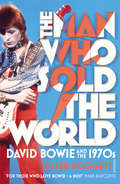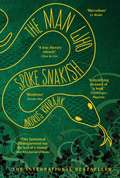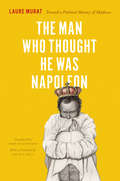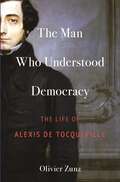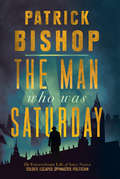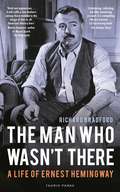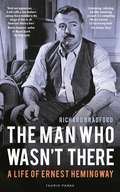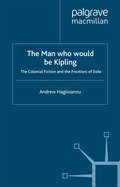- Table View
- List View
The Man Who Sold The World: David Bowie And The 1970s
by Peter DoggettNo artist offered a more incisive and accurate portrait of the troubled landscape of the 1970s than David Bowie. Cultural historian Peter Doggett explores the rich heritage of Bowie's most productive and inspired decade, and traces the way in which his music reflected and influenced the world around him. From 'Space Oddity', his dark vision of mankind's voyage into the unknown terrain of space, to the Scary Monsters album, Doggett examines in detail Bowie's audacious creation of an 'alien' rock star, Ziggy Stardust, and his increasingly perilous explorations of the nature of identity and the meaning of fame.Mixing brilliant musical critique with biographical insight and acute cultural analysis, The Man Who Sold The World is a unique study of a major artist and his times.
The Man Who Spoke Snakish
by Andrus KivirähkUnfortunately people and tribes degenerate. They lose their teeth, forget their language, until finally they're bending meekly on the fields and cutting straw with a scythe.Leemut, a young boy growing up in the forest, is content living with his hunter-gatherer family. But when incomprehensible outsiders arrive aboard ships and settle nearby, with an intriguing new religion, the forest begins to empty - people are moving to the village and breaking their backs tilling fields to make bread. Meanwhile, Leemut and the last forest-dwelling humans refuse to adapt: with bare-bottomed primates and their love of ancient traditions, promiscuous bears, and a single giant louse, they live in shacks, keep wolves, and speak to snakes.Told with moving and satirical prose, The Man Who Spoke Snakish is a fiercely imaginative allegory about a boy, and a nation, standing on the brink of dramatic change.
The Man Who Stole Himself: The Slave Odyssey of Hans Jonathan
by Gisli PalssonThe island nation of Iceland is known for many things—majestic landscapes, volcanic eruptions, distinctive seafood—but racial diversity is not one of them. So the little-known story of Hans Jonathan, a free black man who lived and raised a family in early nineteenth-century Iceland, is improbable and compelling, the stuff of novels. In The Man Who Stole Himself, Gisli Palsson lays out the story of Hans Jonathan (also known as Hans Jónatan) in stunning detail. Born into slavery in St. Croix in 1784, Hans was taken as a slave to Denmark, where he eventually enlisted in the navy and fought on behalf of the country in the 1801 Battle of Copenhagen. After the war, he declared himself a free man, believing that he was due freedom not only because of his patriotic service, but because while slavery remained legal in the colonies, it was outlawed in Denmark itself. He thus became the subject of one of the most notorious slavery cases in European history, which he lost. Then Hans ran away—never to be heard from in Denmark again, his fate unknown for more than two hundred years. It’s now known that Hans fled to Iceland, where he became a merchant and peasant farmer, married, and raised two children. Today, he has become something of an Icelandic icon, claimed as a proud and daring ancestor both there and among his descendants in America. The Man Who Stole Himself brilliantly intertwines Hans Jonathan’s adventurous travels with a portrait of the Danish slave trade, legal arguments over slavery, and the state of nineteenth-century race relations in the Northern Atlantic world. Throughout the book, Palsson traces themes of imperial dreams, colonialism, human rights, and globalization, which all come together in the life of a single, remarkable man. Hans literally led a life like no other. His is the story of a man who had the temerity—the courage—to steal himself.
The Man Who Stole Himself: The Slave Odyssey of Hans Jonathan
by Gisli PalssonThe island nation of Iceland is known for many things—majestic landscapes, volcanic eruptions, distinctive seafood—but racial diversity is not one of them. So the little-known story of Hans Jonathan, a free black man who lived and raised a family in early nineteenth-century Iceland, is improbable and compelling, the stuff of novels. In The Man Who Stole Himself, Gisli Palsson lays out the story of Hans Jonathan (also known as Hans Jónatan) in stunning detail. Born into slavery in St. Croix in 1784, Hans was taken as a slave to Denmark, where he eventually enlisted in the navy and fought on behalf of the country in the 1801 Battle of Copenhagen. After the war, he declared himself a free man, believing that he was due freedom not only because of his patriotic service, but because while slavery remained legal in the colonies, it was outlawed in Denmark itself. He thus became the subject of one of the most notorious slavery cases in European history, which he lost. Then Hans ran away—never to be heard from in Denmark again, his fate unknown for more than two hundred years. It’s now known that Hans fled to Iceland, where he became a merchant and peasant farmer, married, and raised two children. Today, he has become something of an Icelandic icon, claimed as a proud and daring ancestor both there and among his descendants in America. The Man Who Stole Himself brilliantly intertwines Hans Jonathan’s adventurous travels with a portrait of the Danish slave trade, legal arguments over slavery, and the state of nineteenth-century race relations in the Northern Atlantic world. Throughout the book, Palsson traces themes of imperial dreams, colonialism, human rights, and globalization, which all come together in the life of a single, remarkable man. Hans literally led a life like no other. His is the story of a man who had the temerity—the courage—to steal himself.
The Man Who Stole Himself: The Slave Odyssey of Hans Jonathan
by Gisli PalssonThe island nation of Iceland is known for many things—majestic landscapes, volcanic eruptions, distinctive seafood—but racial diversity is not one of them. So the little-known story of Hans Jonathan, a free black man who lived and raised a family in early nineteenth-century Iceland, is improbable and compelling, the stuff of novels. In The Man Who Stole Himself, Gisli Palsson lays out the story of Hans Jonathan (also known as Hans Jónatan) in stunning detail. Born into slavery in St. Croix in 1784, Hans was taken as a slave to Denmark, where he eventually enlisted in the navy and fought on behalf of the country in the 1801 Battle of Copenhagen. After the war, he declared himself a free man, believing that he was due freedom not only because of his patriotic service, but because while slavery remained legal in the colonies, it was outlawed in Denmark itself. He thus became the subject of one of the most notorious slavery cases in European history, which he lost. Then Hans ran away—never to be heard from in Denmark again, his fate unknown for more than two hundred years. It’s now known that Hans fled to Iceland, where he became a merchant and peasant farmer, married, and raised two children. Today, he has become something of an Icelandic icon, claimed as a proud and daring ancestor both there and among his descendants in America. The Man Who Stole Himself brilliantly intertwines Hans Jonathan’s adventurous travels with a portrait of the Danish slave trade, legal arguments over slavery, and the state of nineteenth-century race relations in the Northern Atlantic world. Throughout the book, Palsson traces themes of imperial dreams, colonialism, human rights, and globalization, which all come together in the life of a single, remarkable man. Hans literally led a life like no other. His is the story of a man who had the temerity—the courage—to steal himself.
The Man Who Stole Himself: The Slave Odyssey of Hans Jonathan
by Gisli PalssonThe island nation of Iceland is known for many things—majestic landscapes, volcanic eruptions, distinctive seafood—but racial diversity is not one of them. So the little-known story of Hans Jonathan, a free black man who lived and raised a family in early nineteenth-century Iceland, is improbable and compelling, the stuff of novels. In The Man Who Stole Himself, Gisli Palsson lays out the story of Hans Jonathan (also known as Hans Jónatan) in stunning detail. Born into slavery in St. Croix in 1784, Hans was taken as a slave to Denmark, where he eventually enlisted in the navy and fought on behalf of the country in the 1801 Battle of Copenhagen. After the war, he declared himself a free man, believing that he was due freedom not only because of his patriotic service, but because while slavery remained legal in the colonies, it was outlawed in Denmark itself. He thus became the subject of one of the most notorious slavery cases in European history, which he lost. Then Hans ran away—never to be heard from in Denmark again, his fate unknown for more than two hundred years. It’s now known that Hans fled to Iceland, where he became a merchant and peasant farmer, married, and raised two children. Today, he has become something of an Icelandic icon, claimed as a proud and daring ancestor both there and among his descendants in America. The Man Who Stole Himself brilliantly intertwines Hans Jonathan’s adventurous travels with a portrait of the Danish slave trade, legal arguments over slavery, and the state of nineteenth-century race relations in the Northern Atlantic world. Throughout the book, Palsson traces themes of imperial dreams, colonialism, human rights, and globalization, which all come together in the life of a single, remarkable man. Hans literally led a life like no other. His is the story of a man who had the temerity—the courage—to steal himself.
The Man Who Thought He Was Napoleon: Toward a Political History of Madness
by Laure MuratThe Man Who Thought He Was Napoleon is built around a bizarre historical event and an off-hand challenge. The event? In December 1840, nearly twenty years after his death, the remains of Napoleon were returned to Paris for burial—and the next day, the director of a Paris hospital for the insane admitted fourteen men who claimed to be Napoleon. The challenge, meanwhile, is the claim by great French psychiatrist Jean-Étienne-Dominique Esquirol (1772–1840) that he could recount the history of France through asylum registries. From those two components, Laure Murat embarks on an exploration of the surprising relationship between history and madness. She uncovers countless stories of patients whose delusions seem to be rooted in the historical or political traumas of their time, like the watchmaker who believed he lived with a new head, his original having been removed at the guillotine. In the troubled wake of the Revolution, meanwhile, French physicians diagnosed a number of mental illnesses tied to current events, from “revolutionary neuroses” and “democratic disease” to the “ambitious monomania” of the Restoration. How, Murat asks, do history and psychiatry, the nation and the individual psyche, interface? A fascinating history of psychiatry—but of a wholly new sort—The Man Who Thought He Was Napoleon offers the first sustained analysis of the intertwined discourses of madness, psychiatry, history, and political theory.
The Man Who Thought He Was Napoleon: Toward a Political History of Madness
by Laure MuratThe Man Who Thought He Was Napoleon is built around a bizarre historical event and an off-hand challenge. The event? In December 1840, nearly twenty years after his death, the remains of Napoleon were returned to Paris for burial—and the next day, the director of a Paris hospital for the insane admitted fourteen men who claimed to be Napoleon. The challenge, meanwhile, is the claim by great French psychiatrist Jean-Étienne-Dominique Esquirol (1772–1840) that he could recount the history of France through asylum registries. From those two components, Laure Murat embarks on an exploration of the surprising relationship between history and madness. She uncovers countless stories of patients whose delusions seem to be rooted in the historical or political traumas of their time, like the watchmaker who believed he lived with a new head, his original having been removed at the guillotine. In the troubled wake of the Revolution, meanwhile, French physicians diagnosed a number of mental illnesses tied to current events, from “revolutionary neuroses” and “democratic disease” to the “ambitious monomania” of the Restoration. How, Murat asks, do history and psychiatry, the nation and the individual psyche, interface? A fascinating history of psychiatry—but of a wholly new sort—The Man Who Thought He Was Napoleon offers the first sustained analysis of the intertwined discourses of madness, psychiatry, history, and political theory.
The Man Who Thought He Was Napoleon: Toward a Political History of Madness
by Laure MuratThe Man Who Thought He Was Napoleon is built around a bizarre historical event and an off-hand challenge. The event? In December 1840, nearly twenty years after his death, the remains of Napoleon were returned to Paris for burial—and the next day, the director of a Paris hospital for the insane admitted fourteen men who claimed to be Napoleon. The challenge, meanwhile, is the claim by great French psychiatrist Jean-Étienne-Dominique Esquirol (1772–1840) that he could recount the history of France through asylum registries. From those two components, Laure Murat embarks on an exploration of the surprising relationship between history and madness. She uncovers countless stories of patients whose delusions seem to be rooted in the historical or political traumas of their time, like the watchmaker who believed he lived with a new head, his original having been removed at the guillotine. In the troubled wake of the Revolution, meanwhile, French physicians diagnosed a number of mental illnesses tied to current events, from “revolutionary neuroses” and “democratic disease” to the “ambitious monomania” of the Restoration. How, Murat asks, do history and psychiatry, the nation and the individual psyche, interface? A fascinating history of psychiatry—but of a wholly new sort—The Man Who Thought He Was Napoleon offers the first sustained analysis of the intertwined discourses of madness, psychiatry, history, and political theory.
The Man Who Thought He Was Napoleon: Toward a Political History of Madness
by Laure MuratThe Man Who Thought He Was Napoleon is built around a bizarre historical event and an off-hand challenge. The event? In December 1840, nearly twenty years after his death, the remains of Napoleon were returned to Paris for burial—and the next day, the director of a Paris hospital for the insane admitted fourteen men who claimed to be Napoleon. The challenge, meanwhile, is the claim by great French psychiatrist Jean-Étienne-Dominique Esquirol (1772–1840) that he could recount the history of France through asylum registries. From those two components, Laure Murat embarks on an exploration of the surprising relationship between history and madness. She uncovers countless stories of patients whose delusions seem to be rooted in the historical or political traumas of their time, like the watchmaker who believed he lived with a new head, his original having been removed at the guillotine. In the troubled wake of the Revolution, meanwhile, French physicians diagnosed a number of mental illnesses tied to current events, from “revolutionary neuroses” and “democratic disease” to the “ambitious monomania” of the Restoration. How, Murat asks, do history and psychiatry, the nation and the individual psyche, interface? A fascinating history of psychiatry—but of a wholly new sort—The Man Who Thought He Was Napoleon offers the first sustained analysis of the intertwined discourses of madness, psychiatry, history, and political theory.
The Man Who Touched His Own Heart: True Tales of Science, Surgery, and Mystery
by Rob DunnThe secret history of our most vital organ: the human heart. The Man Who Touched His Own Heart tells the raucous, gory, mesmerizing story of the heart, from the first "explorers" who dug up cadavers and plumbed their hearts' chambers, through the first heart surgeries -- which had to be completed in three minutes before death arrived -- to heart transplants and the latest medical efforts to prolong our hearts' lives, almost defying nature in the process. Thought of as the seat of our soul, then as a mysteriously animated object, the heart is still more a mystery than it is understood. Why do most animals only get one billion beats? (And how did modern humans get to over two billion, effectively letting us live out two lives?) Why are sufferers of gingivitis more likely to have heart attacks? Why do we often undergo expensive procedures when cheaper ones are just as effective? What do Da Vinci, Mary Shelley, and contemporary Egyptian archaeologists have in common? And what does it really feel like to touch your own heart, or to have someone else's beating inside your chest? Rob Dunn's fascinating history of our hearts brings us deep inside the science, history, and stories of the four chambers we depend on most.
The Man Who Touched His Own Heart: True Tales of Science, Surgery, and Mystery
by Rob DunnThe secret history of our most vital organ: the human heart.The Man Who Touched His Own Heart tells the raucous, gory, mesmerizing story of the heart, from the first "explorers" who dug up cadavers and plumbed their hearts' chambers, through the first heart surgeries -- which had to be completed in three minutes before death arrived -- to heart transplants and the latest medical efforts to prolong our hearts' lives, almost defying nature in the process. Thought of as the seat of our soul, then as a mysteriously animated object, the heart is still more a mystery than it is understood. Why do most animals only get one billion beats? (And how did modern humans get to over two billion, effectively letting us live out two lives?) Why are sufferers of gingivitis more likely to have heart attacks? Why do we often undergo expensive procedures when cheaper ones are just as effective? What do Da Vinci, Mary Shelley, and contemporary Egyptian archaeologists have in common? And what does it really feel like to touch your own heart, or to have someone else's beating inside your chest? Rob Dunn's fascinating history of our hearts brings us deep inside the science, history, and stories of the four chambers we depend on most.
The Man Who Understood Democracy: The Life of Alexis de Tocqueville
by Olivier ZunzA definitive biography of the French aristocrat who became one of democracy’s greatest championsIn 1831, at the age of twenty-five, Alexis de Tocqueville made his fateful journey to America, where he observed the thrilling reality of a functioning democracy. From that moment onward, the French aristocrat would dedicate his life as a writer and politician to ending despotism in his country and bringing it into a new age. In this authoritative and groundbreaking biography, leading Tocqueville expert Olivier Zunz tells the story of a radical thinker who, uniquely charged by the events of his time, both in America and France, used the world as a laboratory for his political ideas.Placing Tocqueville’s dedication to achieving a new kind of democracy at the center of his life and work, Zunz traces Tocqueville’s evolution into a passionate student and practitioner of liberal politics across a trove of correspondence with intellectuals, politicians, constituents, family members, and friends. While taking seriously Tocqueville’s attempts to apply the lessons of Democracy in America to French politics, Zunz shows that the United States, and not only France, remained central to Tocqueville’s thought and actions throughout his life. In his final years, with France gripped by an authoritarian regime and America divided by slavery, Tocqueville feared that the democratic experiment might be failing. Yet his passion for democracy never weakened.Giving equal attention to the French and American sources of Tocqueville’s unique blend of political philosophy and political action, The Man Who Understood Democracy offers the richest, most nuanced portrait yet of a man who, born between the worlds of aristocracy and democracy, fought tirelessly for the only system that he believed could provide both liberty and equality.
The Man Who Walked Backward: An American Dreamer's Search For Meaning In The Great Depression
by Ben MontgomeryNone
The Man Who Was Jekyll and Hyde: The Lives and Crimes of Deacon Brodie
by Rick WilsonHe was a respected cabinet-maker and councillor by day – but Deacon William Brodie changed into a sinister, thieving monster when darkness fell on the old city of Edinburgh. Cleverly employing his respectable reputation to access the richest members of society before stealing from them as a masked burglar, he used the resulting illicit money to fund yet another life – with five children and two mistresses. But Brodie – whose chilling story inspired Robert Louis Stevenson to create the classic tale of Dr Jekyll and Mr Hyde about a century later – came fatally unstuck when a captured accomplice informed on him. Then neither his ill-gotten gains nor his steel collar designed to cheat the hangman could save him… Author Rick Wilson offers a warts-and-all biography of Brodie, from his relatively innocent young years through to his public disgrace and execution… hanging on the very gallows he conceived himself.
The Man Who Was Saturday: The Extraordinary Life Of Airey Neave
by Patrick BishopSOLDIER, ESCAPER, SPYMASTER, POLITICIAN – Airey Neave was assassinated in the House of Commons car park in 1979. Forty years after his death, Patrick Bishop’s lively, action-packed biography examines the life, heroic war and death of one of Britain’s most remarkable 20th century figures.
The Man Who Wasn't There: A Life of Ernest Hemingway
by Richard BradfordErnest Hemingway was an involuntary chameleon, who would shift seamlessly from a self-cultivated image of hero, aesthetic radical, and existential non-conformist to a figure made up at various points of selfishness, hypocrisy, self-delusion, narcissism and arbitrary vindictiveness. Richard Bradford shows that Hemingway's work is by parts erratic and unique because it was tied into these unpredictable, bizarre features of his personality. Impressionism and subjectivity will always play some part in the creation of literary works but Hemingway was unique. He was a compulsive liar who eventually became unable to distinguish between the fantasies he spun for family and friends and the stories he told in his fiction.They are the writer's private signature, their authorial fingerprint. In this ground-breaking and intensely revealing biography, which includes a complete reassessment of Hemingway's oeuvre Hemingway's unfixed personality is shown to be the index to why and how he wrote as he did.
The Man Who Wasn't There: A Life of Ernest Hemingway
by Richard BradfordErnest Hemingway was an involuntary chameleon, who would shift seamlessly from a self-cultivated image of hero, aesthetic radical, and existential non-conformist to a figure made up at various points of selfishness, hypocrisy, self-delusion, narcissism and arbitrary vindictiveness. Richard Bradford shows that Hemingway's work is by parts erratic and unique because it was tied into these unpredictable, bizarre features of his personality. Impressionism and subjectivity will always play some part in the creation of literary works but Hemingway was unique. He was a compulsive liar who eventually became unable to distinguish between the fantasies he spun for family and friends and the stories he told in his fiction.They are the writer's private signature, their authorial fingerprint. In this ground-breaking and intensely revealing biography, which includes a complete reassessment of Hemingway's oeuvre Hemingway's unfixed personality is shown to be the index to why and how he wrote as he did.
The Man Who Would Be Kipling: The Colonial Fiction and the Frontiers of Exile
by A. HagiioannuThis study places Kipling's fiction in its original cultural, intellectual and historical contexts, exploring the impact of India, America, South Africa and Edwardian England on his imperialist narratives. Drawing on manuscripts, journalism and unpublished writings, Hagiioannu uncovers the historical significance and hidden meanings of a broad range of Kipling's stories, extending the discussion from the best-known works to a number of less familiar tales. Through a combination of close textual analysis and lively historical coverage, The Man Who Would Be Kipling suggests that Kipling's political ideas and narrative modes are more subtly connected with lived experience and issues of cultural environment than critics have formerly recognized.
The Man who Would be Sherlock: The Real Life Adventures of Arthur Conan Doyle
by Christopher SandfordWhen Arthur Conan Doyle was a lonely 7-year-old schoolboy at pre-prep Newington Academy in Edinburgh, a French émigré named Eugene Chantrelle was engaged there to teach Modern Languages. A few years later, Chantrelle would be hanged for the particularly grisly murder of his wife, marking the beginning of Conan Doyle’s own association with some of the bloodiest crimes of the Victorian and Edwardian eras. This early link between actual crime and the greatest detective story writer of all time is one of many. Conan Doyle would also go on to play a leading role in the notorious case of the young Anglo-Indian lawyer George Edalji, convicted and imprisoned as the ‘mad ripper’ who supposedly prowled the fields around his Staffordshire home by night looking for animals to mutilate; and the equally chilling story of Oscar Slater and his alleged murder of an elderly spinster as she sat in her Glasgow home one winter’s night in 1908, a crime with a spectacular denouement 18 years later. Using freshly available evidence and eyewitness testimony, Christopher Sandford follows these links and draws out the connections between Conan Doyle’s literary output and factual criminality, a pattern that will enthral and surprise the legions of Sherlock Holmes fans. In a sense, Conan Doyle wanted to be Sherlock – to be a man who could bring order and justice to a terrible world.
The Man With the Iron Heart: The Definitive Biography of Reinhard Heydrich, Architect of the Holocaust
by Nancy DoughertyA fascinating portrait of Reinhard Heydrich, one of the darkest figures of Hitler's elite, featuring words with those who knew him best, including in-depth and rare interviews with his wife, Lina. He was called the 'Hangman of the Gestapo' and the 'Butcher of Prague'. He had a reputation as a ruthlessly efficient killer and was known as an exemplar of Nazi ideals. He was the head of the SS and the Gestapo, second in command to Heinrich Himmler and supposedly in line to succeed the Fuhrer.His orders set in motion the Kristallnacht pogrom of 1938 and he was the lead planner of the Final Solution, which led to the murder of millions of Jews across Nazi-occupied Europe.Hitler called him 'the man with the iron heart'.This incredible biography explores who Reinhard Heydrich was, how he came to be and what led him to do what he did.Using in-depth research, Nancy Dougherty (and, following her death, Christopher Lehman-Haupt), paint a detailed picture of Heydrich as never seen before. Through extensive interviews with those who knew him best, including his wife Lina von Osten Heinrich, we hear about his rarefied musical family origins and ugly-duckling childhood, his failed Naval career and struggles to find employment, and finally his meteoric rise through the Nazi high command and his time within the Third Reich.The Man With the Iron Heart is an astonishing journey into the depths of Nazi evil and a powerful insight into one of humanity's darkest figures.
The Man with the Poison Gun: A Cold War Spy Story
by Serhii PlokhyIn the fall of 1961, KGB assassin Bogdan Stashinsky defected to West Germany. After spilling his secrets to the CIA, Stashinsky was put on trial in what would be the most publicized assassination case of the entire Cold War. The publicity stirred up by the Stashinsky case forced the KGB to change its modus operandi abroad and helped end the career of Aleksandr Shelepin, one of the most ambitious and dangerous Soviet leaders. Stashinsky's testimony, implicating the Kremlin rulers in political assassinations carried out abroad, shook the world of international politics. Stashinsky's story would inspire films, plays, and books-including Ian Fleming's last James Bond novel, The Man with the Golden Gun.A thrilling tale of Soviet spy craft, complete with exploding parcels, elaborately staged coverups, double agents, and double crosses, The Man with the Poison Gun offers unparalleled insight into the shadowy world of Cold War espionage.
A Man Without Breath: fast-paced historical thriller from a global bestselling author (Bernie Gunther #9)
by Philip Kerr'One of the greatest anti-heroes ever written' LEE CHILDBerlin, March 1943. The mood in Germany is bleak after their stunning defeat at Stalingrad. Private Investigator Bernie Gunther is at work in the German War Crimes Bureau - weary, cynical but well aware of the value of truth in a world where that's now a rarity. When human remains are found deep in the Katyn Forest, Bernie is sent to investigate. Rumour has it that this mass grave is full of Polish officers murdered by the Russians. For Josef Goebbels, proof of Russian involvement is sure to destroy the Western Alliance, giving Germany a chance to reverse its devastating losses. But supposing the truth is far more damaging to the German cause? It's Bernie Gunther's job to give Goebbels what he needs. But when there's nothing left for Gunther to lose, the compulsion to speak the truth becomes ever stronger...
Managed Speech: The Roberts Court's First Amendment
by Gregory P. MagarianOur constitutional freedom to speak out against government and corporate power is always fragile, but today it faces unprecedented hazards. In Managed Speech: The Roberts Court's First Amendment, leading First Amendment scholar, Gregory Magarian, explores and critiques how the present U.S. Supreme Court, led by Chief Justice John Roberts, has reshaped and degraded the law of expressive freedom. This timely book shows how the Roberts Court's free speech decisions embody a version of expressive freedom that Professor Magarian calls "managed speech". Managed speech empowers stable, responsible institutions, both government and private, to manage public discussion; disfavors First Amendment claims from social and political outsiders; and, above all, promotes social and political stability. Professor Magarian examines all of the more than forty free speech decisions the Supreme Court handed down between Chief Justice Roberts' ascent in 2005 and Justice Antonin Scalia's death in 2016. Those decisions, taken together, aggressively advance stability at a steep cost to robust public debate. Professor Magarian proposes a theoretical alternative to managed speech, one that would aim to increase the range of ideas and voices in public discussion: "dynamic diversity." A First Amendment doctrine based on dynamic diversity would prioritize political dissent and the rights of journalists, allow for reasonable regulations of money in politics, and work to broaden opportunities for speakers to be heard. This book offers a fresh, critical perspective on the crucial question of what the First Amendment should mean and do.
Managed Speech: The Roberts Court's First Amendment
by Gregory P. MagarianOur constitutional freedom to speak out against government and corporate power is always fragile, but today it faces unprecedented hazards. In Managed Speech: The Roberts Court's First Amendment, leading First Amendment scholar, Gregory Magarian, explores and critiques how the present U.S. Supreme Court, led by Chief Justice John Roberts, has reshaped and degraded the law of expressive freedom. This timely book shows how the Roberts Court's free speech decisions embody a version of expressive freedom that Professor Magarian calls "managed speech". Managed speech empowers stable, responsible institutions, both government and private, to manage public discussion; disfavors First Amendment claims from social and political outsiders; and, above all, promotes social and political stability. Professor Magarian examines all of the more than forty free speech decisions the Supreme Court handed down between Chief Justice Roberts' ascent in 2005 and Justice Antonin Scalia's death in 2016. Those decisions, taken together, aggressively advance stability at a steep cost to robust public debate. Professor Magarian proposes a theoretical alternative to managed speech, one that would aim to increase the range of ideas and voices in public discussion: "dynamic diversity." A First Amendment doctrine based on dynamic diversity would prioritize political dissent and the rights of journalists, allow for reasonable regulations of money in politics, and work to broaden opportunities for speakers to be heard. This book offers a fresh, critical perspective on the crucial question of what the First Amendment should mean and do.
